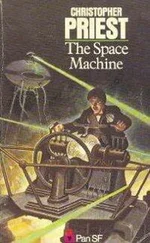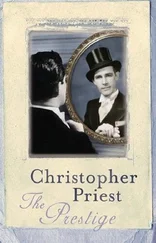Christopher Priest - The Separation
Здесь есть возможность читать онлайн «Christopher Priest - The Separation» весь текст электронной книги совершенно бесплатно (целиком полную версию без сокращений). В некоторых случаях можно слушать аудио, скачать через торрент в формате fb2 и присутствует краткое содержание. Год выпуска: 0101, Жанр: Фантастика и фэнтези, на английском языке. Описание произведения, (предисловие) а так же отзывы посетителей доступны на портале библиотеки ЛибКат.
- Название:The Separation
- Автор:
- Жанр:
- Год:0101
- ISBN:нет данных
- Рейтинг книги:5 / 5. Голосов: 1
-
Избранное:Добавить в избранное
- Отзывы:
-
Ваша оценка:
- 100
- 1
- 2
- 3
- 4
- 5
The Separation: краткое содержание, описание и аннотация
Предлагаем к чтению аннотацию, описание, краткое содержание или предисловие (зависит от того, что написал сам автор книги «The Separation»). Если вы не нашли необходимую информацию о книге — напишите в комментариях, мы постараемся отыскать её.
The Separation — читать онлайн бесплатно полную книгу (весь текст) целиком
Ниже представлен текст книги, разбитый по страницам. Система сохранения места последней прочитанной страницы, позволяет с удобством читать онлайн бесплатно книгу «The Separation», без необходимости каждый раз заново искать на чём Вы остановились. Поставьте закладку, и сможете в любой момент перейти на страницу, на которой закончили чтение.
Интервал:
Закладка:
Hess will no doubt receive what he deserves, as will in the end Herr Hitler. Yr. report is a great credit to you. I wish to apologize once again for my insensitive remarks concerning yr. late bro., which were based on a misunderstanding within my department. I held him in the highest regard.
WSC
(I never again saw the man who stood in for Rudolf Hess. He remained a prisoner in Britain until the end of the war, with no information about him being released to the public. He frequently feigned amnesia and madness, but always maintained he was Hess. He was taken to Nuremberg in October 1945, where he was indicted under all four Counts as a war criminal. He was found guilty on Counts One and Two - Conspiracy to Wage Aggressive War and Waging Aggressive War - but not guilty on Counts Three and Four - War Crimes and Crimes Against Humanity. He was sentenced to life imprisonment. Because of Soviet suspicions about Hess, he was not allowed remission against his sentence. He therefore served forty-two years in prison (forty-six years when the time spent in Britain is included). For the last years of his life he was the sole prisoner in Spandau Prison, West Berlin. He never appealed against his sentence on the grounds of wrongful conviction or mistaken identity. He refused to see Frau Ilse Hess or her son Wolf for many years, finally relenting in 1969 when he mistakenly believed he was near death. At the time he was seventy-five years old. Frau Hess had not seen her husband for more than twenty-eight years. Medical examination of the prisoner in 1973 could find no trace of the scarring that would have been caused by rifle bullet injuries known to have been sustained by Rudolf Hess during the First World War. This is the only forensic evidence made public that supports my own belief about the imposture, because scars caused by bullet wounds never disappear. The prisoner died in mysterious circumstances while he was still being held in Spandau, in August 1987. A suicide note found by the body appeared to have been written many years earlier. Post-mortem examination of the body did not establish conclusive cause of death, other than asphyxiation. In some quarters his death is regarded as murder. Again, no sign of heavy scarring from war injuries was found on the body. Soon after the death of the prisoner, Spandau Prison was demolished to prevent it becoming a shrine for neo-Nazis. The body was laid to rest by the family in a secret location. Some time later, it was moved to the family plot in Wunsiedel. The prisoner’s real identity, if known, was never revealed by the authorities.)
24
After my spell working for Churchill I was posted back to 148 Squadron in September 1941 and in theory resumed operational flights in December. In reality, because of my long absence, I was sent on a flying refresher course to an airfield on the Welsh coast near Aberystwyth. When I returned to Tealby Moor I was assigned a new flight-crew, but almost at once the news came through that 148 Squadron was converting to four-engined heavy bombers.
Once again, the squadron was taken out of the front line and many of the personnel started to disperse to other postings. While I was working with Churchill I heard a report that 148 Squadron had been selected for conversion to the new Lancaster bomber. For that reason I opted to stay on. I was posted to an RAF base in Scotland used by an HCU (Heavy Conversion Unit), where I was introduced to the new plane, first by training on its immediate two-engined predecessor, the Manchester, then by practising on the Halifax, another four-engined plane of slightly older design. I was therefore one of the first RAF pilots to fly the Lancaster operationally, the plane that over the next few years was to become the backbone of the RAF’s bombing campaign against Germany.
In 1942 the Lancaster represented a radical breakthrough in bomber design. It could fly faster, higher and further than any existing type. It was strong, well defended and carried a much larger and more varied payload of bombs. It was equipped with Rolls-Royce Merlin engines - the same unit that powered the famous Spitfire fighter - and it flew like a dream, laden or empty.
After two weeks of familiarization training at the HCU, working with my new crew, we were sent back to Tealby Moor. In due course the squadron started taking deliveries of Lancasters from the factory and by mid-May we were ready to become operational again. My first Lancaster raid was on the German town of Mannheim, but after that ‘blooding’ we were once again taken out of operations. Two weeks later, during which rumours were constantly circulating that the Air Ministry was preparing a ‘spectacular’, I took part in the first so-called thousand-bomber raid on the city of Cologne on May 30, 1942.
These two missions, to Mannheim and Cologne, were in some respects routine affairs: we experienced no technical difficulties with the aircraft, we came under no sustained attack, we dropped our bomb load as close as we could to the target area and we returned home safely. Apart from an extra feeling of nervousness, as it was more than a year since I had flown on a raid, the main practical difference was the fact of flying the Lancaster. However, both the raids had a signal effect on me, if for different reasons.
The day after we went to Mannheim we received photographic evidence of our bombing results. As I was a senior operational pilot in the squadron I went to the debriefing session where the photographs were produced. The pictures revealed that the raid had been an almost total failure: most of the bombs we dropped fell in open countryside or forest, some of them many miles from the town. Only a handful of bombs fell where intended and these had started fires in a small industrial area. There was a scattering of bomb or incendiary damage over the rest of the town, all of it minor. At the same time, we already knew that of the two hundred RAF aircraft sent to Mannheim that night, eleven had been shot down. No parachutes were seen.
Each plane carried a crew of five or seven men, depending on the type of aircraft: around seventy young men were dead. By any standards it was a disaster, with unknowable but all too imaginable impact on the families, friends and colleagues of the dead men. Seventy men dead for what?
While the raid on Mannheim was a ‘failure’ in strategic terms, the attack that followed was a ‘success’. It was carried out as a show of Bomber Command’s strength, to demonstrate to the enemy that we possessed the ability to put a thousand bombers into the skies above a German city and bomb it into oblivion.
A thousand planes were in fact sent, although less than half were from front-line operational squadrons. Most of the aircraft were found elsewhere: mostly from OTUs (Operational Training Units) or HCUs. Some of these planes were piloted by instructors, but many others were flown by trainee pilots. The Germans were not to know this, however, and the effect of the raid was devastating, both as propaganda and in terms of damage to the target.
148 Squadron was despatched to Cologne late in the evening, so when we arrived over the city much of the bombing had already been completed. We were at twenty thousand feet, close to the Lancaster’s operating ceiling. We took advantage of this to stay above the general level of activity. As we turned in to start our bombing run the city lay ahead of us, already blazing and smoking, fires spreading out in all directions. Planes below us were silhouetted against the terrible conflagration. Pinpoints of brilliant light, our incendiaries, lay like ten thousand glinting beads on the streets, roofs and gardens below. Flares tumbled down, spitting magnesium light like immense escaped fireworks, illuminating the horrors on the ground. Whole districts were ablaze, as individual fires reached out and joined up with others, the flames dazzling yellows, whites and reds, mottled by the bulging, rising smoke. Explosions continued in every part of the city, shattering the buildings, blasting them open so that the incendiaries might take a better hold.
Читать дальшеИнтервал:
Закладка:
Похожие книги на «The Separation»
Представляем Вашему вниманию похожие книги на «The Separation» списком для выбора. Мы отобрали схожую по названию и смыслу литературу в надежде предоставить читателям больше вариантов отыскать новые, интересные, ещё непрочитанные произведения.
Обсуждение, отзывы о книге «The Separation» и просто собственные мнения читателей. Оставьте ваши комментарии, напишите, что Вы думаете о произведении, его смысле или главных героях. Укажите что конкретно понравилось, а что нет, и почему Вы так считаете.











